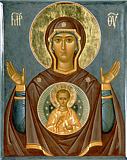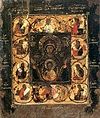

| Previous day | Next day |
| Old Style
November 27
|
Monday |
New Style
December 10
|
|
29th Week after Pentecost.
Tone 3.
Nativity Fast. |
Wine and oil allowed.
|
![]() Commemoration of the Miracle of the Weeping Icon of the Most Holy Theotokos “Of the Sign” at Novgorod (1170).
Commemoration of the Miracle of the Weeping Icon of the Most Holy Theotokos “Of the Sign” at Novgorod (1170). ![]() Great-martyr James the Persian (421).
Great-martyr James the Persian (421). ![]() St. Palladius of Thessalonica (6th c.-7th c.).
St. Palladius of Thessalonica (6th c.-7th c.). ![]() Uncovering of the relics of St. Vsevolod (in baptism Gabriel), prince and wonderworker of Pskov (1192).
Uncovering of the relics of St. Vsevolod (in baptism Gabriel), prince and wonderworker of Pskov (1192). ![]() St. James, bishop and wonderworker of Rostov (1392). St. Andrew Ogorodnikov, fool-for-Christ, of Simbirsk (1841). Synaxis of the New Martyrs and Confessors of Radonezh.
St. James, bishop and wonderworker of Rostov (1392). St. Andrew Ogorodnikov, fool-for-Christ, of Simbirsk (1841). Synaxis of the New Martyrs and Confessors of Radonezh.
17 Monk-martyrs in India (4th c.). St. Romanus the Wonderworker, of Cilicia, near Antioch (5th c.). St. Diodorus, founder of Yeriegorsk Monastery (Solovki) (1633).
New Hieromartyrs Nicholas (Dobronravov), archbishop of Vladimir, Nikon (Belyaev), archimandrite, of the Staro- Golutvin Monastery (Kolomna), Ioasaph (Boyev), archimandrite, of Nikolskoye Monastery (Moscow), Nicholas (Saltykov), hieromonk of the St. Nicholas-Peshnosha Monastery (Moscow), and Apollos (Fedoseyev), hieromonk, of Moscow (1937). New Hieromartyr Cronides, archimandrite, and with him Seraphim (Krestianinov), abbot, and Xenophont (Bondarenko), hieromonk, all of St. Sergius Lavra (1937).
Icons of the Most Holy Theotokos “Of the Sign”: “Kursk Root” (1295) “Of Abalak” (1637), “Of Tsarskoe Selo,” and “Of Seraphimo-Ponetaev.” (1879)
St. Pinuphrius of Egypt (4th c.). St. Palladius, bishop of Elenopolis, author of The Lausaic History (ca. 430). St. Maximus of Riez (ca. 460). St. Nathaniel of Nitria (6th c.). St. Virgil, bishop of Salzburg, Irish missionary (784).
Repose of Hieromonk Athanasius of Iveron, Mt. Athos (1973).
Thoughts for Each Day of the Year
According to the Daily Church Readings from the Word of God
By St. Theophan the Recluse

Monday. [II Tim. 2:20-26; Luke 19:37-44]
The people cry out: “hosanna!”—while the Lord weeps. Does not something similar occur at our church celebrations? In those days, there was a solemn resemblance; but the Lord looked at what was in the souls invisibly, and saw it to be worthy of weeping. For us also, the holiday is always visibly festive; but is everyone’s inner mood this way? One has no understanding at all of the power and meaning of holidays; another gropingly feels something darkly, but sees nothing clearly; while another remains almost unnoticed, but his feeling and mood are worthy of the festive occasion. Our holidays take many sacrifices. But how many of them are intended for the Lord and one’s brothers and sisters? Either none, or the most insignificant bit; one’s belly and vain rushing around take almost all. This cannot be concealed from the Lord, and it is not surprising if, to speak in a human way, He weeps when we utter festive exclamations. These are those redeemed, justified, adopted as sons!…They gave a promise, took on an obligation to walk in the spirit and not commit fleshly lusts, while here what goes on among them? The sons of the Kingdom are worse than the basest slaves!…
Articles
 Greatmartyr James the Persian |
 Icon of the Mother of God “Kursk-Root”The Kursk Root Icon of the Mother of God “Of the Sign” is one of the most ancient icons of the Russian Church. |
 Icon of the Mother of God “Seraphim-Ponetaevka”Six years after it was painted, the icon became known for its numerous miracles and became the chief holy item of the monastery. |





